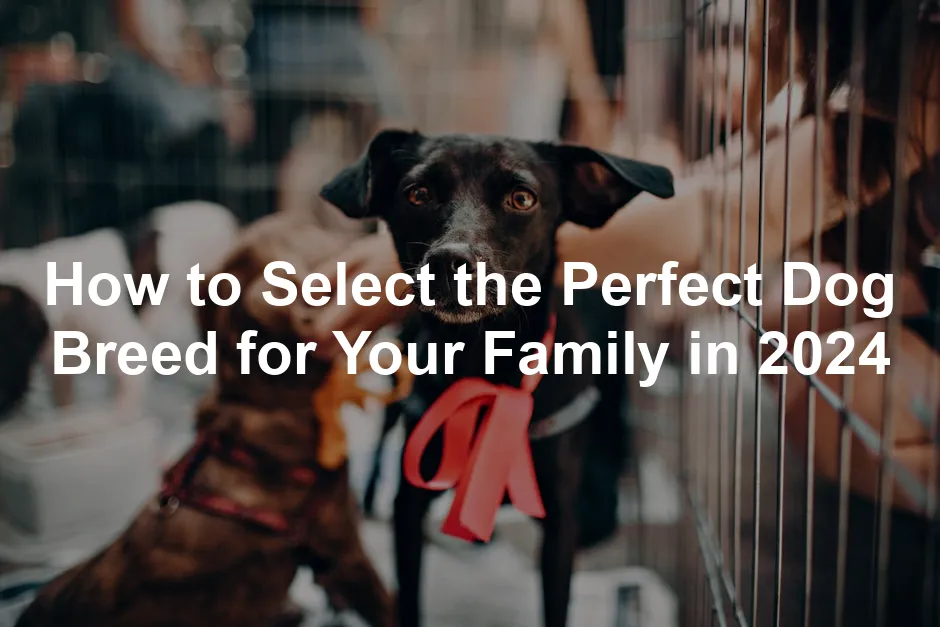Introduction
Bringing a dog into your family is thrilling! Dogs offer companionship, loyalty, and joy. However, choosing the right breed is crucial. The perfect breed can significantly enhance your family’s dynamics and lifestyle.
Summary and Overview
When selecting a dog, consider your family’s unique needs and lifestyle. Key factors include activity level, space, and grooming requirements. Researching breed characteristics helps ensure you make an informed decision. This article will guide you through understanding your family’s needs, assessing lifestyle factors, and choosing the right dog for your home. Expect practical advice, breed recommendations, and insights into what makes a great family dog.
Understanding Your Family’s Needs
Assessing Family Lifestyle
Your family’s energy level and daily activities play a major role in choosing a dog breed. An active family enjoys outdoor adventures and may prefer high-energy breeds like Labrador Retrievers or Border Collies. These dogs thrive on exercise and companionship, making them ideal for families that love to play and explore.
On the other hand, if your family enjoys quieter activities, consider breeds that are content with less exercise. Breeds like Bulldogs or Basset Hounds are often happy with short walks and cozy time on the couch. Matching your family’s lifestyle with a dog’s exercise needs is essential for a harmonious home.

Don’t forget to think about how much time your family can commit to a dog’s care. If your schedule is busy, a breed that can adapt to being alone for longer periods may be a better fit. Understanding these aspects will help you select a breed that complements your family’s lifestyle.
While you’re pondering, don’t overlook the importance of having the right supplies! A Dog Food and Water Bowls Set is essential for keeping your furry friend well-fed and hydrated, making mealtime a breeze!
Family Size and Dynamic
When choosing a dog breed, family size matters. More family members mean more energy! Larger families often find joy with breeds like Labrador Retrievers or Golden Retrievers. These breeds are friendly, adaptable, and great with kids.
Consider ages too. Families with young children need patient dogs. Breeds like Beagles or Cavalier King Charles Spaniels are gentle and playful. They can handle the excitement of kids while providing companionship.
If you have older kids, active breeds like Boxers or Border Collies might be perfect. They love to play and can keep up with energetic teens. Understanding your family’s dynamic helps in picking the right breed for a happy home.

And of course, what’s a happy dog without a comfy place to rest? Consider investing in a Dog Bed for Comfort to give your new furry friend the perfect spot to snooze after a long day of play!
Space Requirements
Living space plays a huge role in breed selection. If you live in an apartment, smaller breeds often fit best. Consider breeds like French Bulldogs or Pugs; they adapt well to limited space and don’t require extensive exercise.
For families with houses and yards, medium to large breeds thrive. Golden Retrievers and German Shepherds enjoy having room to roam and play. Ensure your yard is secure and spacious enough for their needs.

Remember, each breed has different space requirements. A dog’s happiness often relies on having enough room to move around comfortably. Choose wisely based on your living situation.
And don’t forget, a Durable Dog Leash is essential for those walks in the park! A sturdy leash keeps your dog safe and secure while you enjoy the great outdoors together.
Key Factors in Selecting a Breed
Energy Levels
Energy levels vary widely among dog breeds. High-energy breeds, like Border Collies and Siberian Huskies, need plenty of exercise. They are best suited for active families who enjoy outdoor activities.
If your family prefers a more relaxed lifestyle, consider low-energy breeds. Bulldogs or Shih Tzus are usually content with short walks and indoor playtime. Matching a breed’s energy level with your family’s activity is crucial.

Think about your daily routine. How much time can you dedicate to exercise? Understanding your family’s lifestyle helps in selecting a breed that fits seamlessly.
Another vital factor is having the right training treats! Dog Training Treats can make all the difference when it comes to teaching your new companion tricks and commands. They’ll be eager to learn when they know there’s a tasty reward waiting for them!
Temperament and Personality Traits
Understanding a dog’s temperament is essential in selecting the right breed. Some breeds are known for their friendly and sociable nature. Golden Retrievers and Labradors are excellent examples; they are gentle and great with children.
Other breeds, like Rottweilers or German Shepherds, can be more protective. They are ideal for families looking for a loyal companion. If you have other pets, consider breeds that are known for their compatibility with them.

Each breed has unique personality traits. Spend time with different breeds to see which fits your family best. This ensures a harmonious relationship with your new furry friend.
And let’s not forget about the grooming aspect! A well-rounded Dog Grooming Kit can make managing your furry friend’s coat a breeze. Regular grooming keeps your dog looking their best and helps prevent matting!
Grooming Needs
When selecting a dog breed, grooming requirements are essential to consider. Different breeds have varying needs for coat care, shedding, and maintenance. For instance, long-haired breeds like Afghan Hounds and Yorkshire Terriers require regular grooming to prevent matting. In contrast, short-haired breeds like Beagles or Boxers typically demand less upkeep.
Shedding can also vary greatly. Breeds like Labrador Retrievers shed frequently, while hypoallergenic options such as Poodles or Bichon Frises produce less dander, making them ideal for allergy sufferers. For more information on hypoallergenic breeds, check out this article on Best hypoallergenic dog breeds for allergy sufferers.

If your family has a busy schedule, consider low-maintenance breeds. Bulldogs or Dachshunds often need minimal grooming and are content with moderate exercise. This way, you can enjoy your furry friend without feeling overwhelmed by grooming tasks.
Common Health Issues by Breed
Health considerations are crucial when selecting a dog. Certain breeds have predispositions to specific health issues. For instance, large breeds like Great Danes often face hip dysplasia or heart problems. Smaller breeds, such as Dachshunds, may be prone to back issues.
It’s vital to choose a breed with manageable health concerns. Researching breed-specific health issues can prepare you for potential challenges. Selecting a breed known for good health can lead to a happier, longer-lasting companionship.

Furthermore, regular veterinary check-ups and a healthy diet can significantly reduce health risks. Always consult your vet when considering a breed to ensure it aligns with your family’s health expectations.
Allergies and Sensitivities
Allergies can be a significant concern for families. If anyone in your household is sensitive to pet dander, consider hypoallergenic breeds. Poodles, Schnauzers, and Bichon Frises are known to produce less dander, making them suitable for allergy sufferers.
However, no breed is entirely hypoallergenic. It’s wise to spend time with a breed before committing. This helps gauge compatibility with family members’ sensitivities.

Testing compatibility is crucial. Visit shelters or breeders to interact with potential breeds. This way, you ensure that your new furry friend complements your family’s health needs without causing discomfort.
Benefits of Adoption
Adopting a dog from a shelter or rescue group offers numerous advantages. First, it gives a homeless dog a loving home, providing them a second chance at life. Shelters often have a variety of breeds available, from mixed breeds to purebreds.
Additionally, adoption is typically more cost-effective than buying from breeders. Many shelters cover initial vaccinations, spaying, or neutering, which can save you money.

Moreover, shelter staff can help match you with a dog that fits your family’s needs. They often have insight into each dog’s personality, helping you choose a companion that aligns with your lifestyle. Adopting not only enriches your life but also benefits a dog in need.
Responsible Breeding Practices
Choosing the right breeder is crucial for your new puppy’s health and temperament. Look for reputable breeders who prioritize ethical practices. They should be transparent about their breeding processes and provide health clearances for their dogs. Health checks can identify potential genetic issues, ensuring you bring home a healthy companion.
A responsible breeder will encourage you to meet both the puppies and their parents. This helps you assess the temperament of the pups and understand the environment they were raised in. Puppies from responsible sources often come with a better socialization foundation, making them easier to train and adapt to family life.

By selecting a puppy from a responsible breeder, you significantly enhance your chances of a long, happy relationship with your new furry friend.
Essential Supplies and Home Preparations
Before bringing your new dog home, gather essential supplies to ensure a smooth transition. You’ll need food and water bowls, high-quality dog food, a comfortable bed, and toys for mental stimulation. Don’t forget a collar with an ID tag and a leash for walks.
Puppy-proofing your home is equally important. Remove hazardous items like electrical cords, small objects, and toxic plants. Secure trash bins and keep cleaning supplies out of reach. Designate a safe space where your new dog can relax and feel secure.

Having these supplies ready will help your new furry friend settle into your home with ease.
For those cozy nights, a Dog Blanket for Comfort can keep your pup warm and snuggly while they curl up on the couch with you!
Establishing Routines
Creating routines is vital for your new dog’s adjustment and training. Dogs thrive on consistency, so set a schedule for feeding, bathroom breaks, and playtime. This helps them understand what to expect daily.
When your dog arrives, introduce them to their designated areas and supplies. Offer plenty of positive reinforcement during training sessions to encourage desired behaviors. Establishing a routine helps your dog feel secure and builds trust between you and your new companion.

Consistency is key to a smooth transition and a happy home.
FAQs
What is the best dog breed for families with children?
When it comes to family-friendly dogs, several breeds shine. Labrador Retrievers are known for their gentle nature and eagerness to please. Golden Retrievers also rank high, thanks to their patience and playful demeanor. Beagles and Cavalier King Charles Spaniels are excellent choices too. They are friendly and adapt well to children’s energy levels. Always consider a dog’s temperament and energy to ensure a good match with your family.
How do I know if I’m ready for a dog?
Assessing your readiness for a dog starts with understanding your lifestyle. Are you home often enough to provide companionship? Dogs require time, attention, and training. Consider your family’s schedules and commitments. If you have young children, do you have the patience for training? Reflect on your ability to meet a dog’s needs, including exercise and socialization, before deciding.
Are there hypoallergenic dog breeds?
Yes, there are hypoallergenic breeds that produce less dander, making them suitable for allergy sufferers. Breeds like Poodles, Bichon Frises, and Schnauzers are popular choices. However, no dog is entirely hypoallergenic. It’s wise to spend time with a breed to check for any allergic reactions. This ensures a comfortable environment for everyone in the family.
What should I consider when adopting a dog?
Adopting a dog is a rewarding experience, but several factors should be considered. First, think about the breed’s characteristics and how they fit your lifestyle. Consider the dog’s age, size, and energy level. Additionally, assess any health issues common to the breed. Finally, ask about the dog’s temperament and history to ensure a good match for your family.
How much exercise does my dog need?
A dog’s exercise needs vary significantly based on its breed and energy level. High-energy breeds, like Border Collies or Labradors, require daily vigorous exercise, often exceeding an hour. Low-energy breeds, such as Bulldogs, may be content with shorter walks. Consider your family’s activity level and schedule when choosing a breed. Matching your dog’s exercise requirements with your lifestyle will lead to a happier, healthier pet.
And for those unexpected messes, don’t forget to have a pack of Dog Waste Bags Dispenser handy for those walks around the neighborhood! It’s an essential for responsible pet ownership.
Please let us know what you think about our content by leaving a comment down below!
Thank you for reading till here 🙂
All images from Pexels





